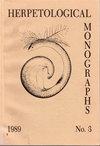核糖体DNA与青蛙的系统发育
IF 1.1
2区 生物学
Q3 ZOOLOGY
引用次数: 22
摘要
对蛙类28S核糖体RNA基因中1656个对齐位点的系统发育分析支持了最近发现的一些高等类群,但对其他类群提供了相反的支持。28S rDNA数据支持最近发现的Pipanura (me- sobatrachians + neobatrachians)的单系性,这反过来又表明了archaeobatrachians的部分。在形态学分析中被认为是副系或弱单系的Me- sobatrachians (pelobatoids + pipoids)也从28S rDNA数据中得到了单系类群的支持。水螅总科(= bufono总科)被广泛认识,但缺乏更多的生理支持,作为单系植物得到一些分子支持。然而,由形态学支持的Ranoidea受到核糖体DNA的反支持。特别地,齿舌虫不与类目动物群(但有时与舌目动物群)。对Duellman和Trueb (1986: Am- phibians Biology of Am- phibians)的分子数据和形态学数据的综合分析支持Pipanura, Mesobatrachia, Neobatrachia和hylo总科,但显示类蛙类为副类(与水螅总科有亲缘关系)。在anuran树的几个区域的分子和形态数据之间的一致性表明,传统上不稳定的高等蛙分类正在趋于稳定。本文章由计算机程序翻译,如有差异,请以英文原文为准。
RIBOSOMAL DNA AND THE PHYLOGENY OF FROGS
Phylogenetic analysis of 1656 aligned sites in the 28S ribosomal RNA gene of frogs supports some of the recently recognized higher groups of anurans but provides counter-support for others. The 28S rDNA data support the monophyly of the recently recognized Pipanura (me- sobatrachians plus neobatrachians), which in turn indicates paraphyly of archaeobatrachians. Me- sobatrachians (pelobatoids plus pipoids), which are either considered paraphyletic or weakly sup- ported as monophyletic in morphological analyses, also receive support as a monophyletic group from the 28S rDNA data. Hyloidea (= Bufonoidea), which is widely recognized but lacks mor- phological support, receives some molecular support as being monophyletic. However, Ranoidea, which is supported by morphology, is counter-supported by ribosomal DNA. In particular, den- drobatids do not group with ranids (but sometimes group with hyloids). A combined analysis of the molecular data with the morphological data of Duellman and Trueb (1986:Biology of Am- phibians) supports Pipanura, Mesobatrachia, Neobatrachia, and Hyloidea, but shows the ranoids as paraphyletic (with Dendrobatidae related to Hyloidea). The agreement between molecular and morphological data in several regions of the anuran tree indicates an approaching stabilization of traditionally labile higher frog classification.
求助全文
通过发布文献求助,成功后即可免费获取论文全文。
去求助
来源期刊

Herpetological Monographs
生物-动物学
CiteScore
5.40
自引率
0.00%
发文量
2
审稿时长
>12 weeks
期刊介绍:
Since 1982, Herpetological Monographs has been dedicated to original research about the biology, diversity, systematics and evolution of amphibians and reptiles. Herpetological Monographs is published annually as a supplement to Herpetologica and contains long research papers, manuscripts and special symposia that synthesize the latest scientific discoveries.
 求助内容:
求助内容: 应助结果提醒方式:
应助结果提醒方式:


